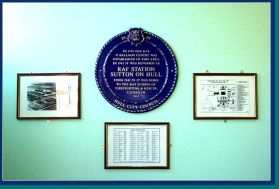S u t t o n & W a w n e M u s e u m
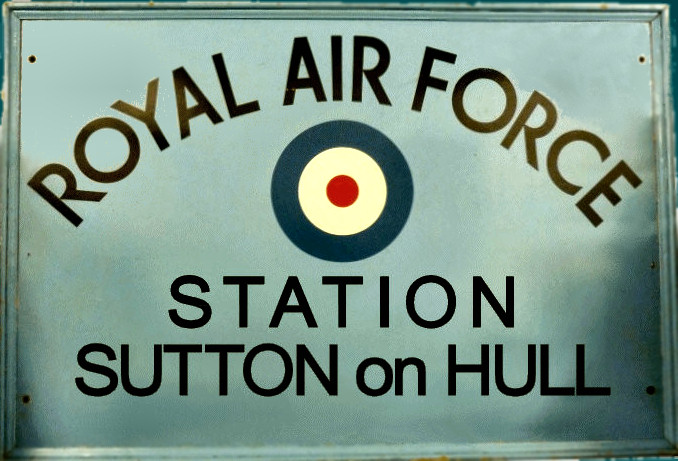

17 Balloon Centre |
|||
|
LEN BACON
This page only gives brief details of the
above titled book, now out of print and no
longer available for sale at our museum.
But, all is not lost, it is available to
view online, by the excellent work of our
good friends at HullWebs, on the link below.
It was Len's drive and dedication that led
to so much history about the RAF's time here
being revealed for all. It was his
insistance that the contribution to the
defence of Hull of former colleagues who
served with him in Sutton during World War
Two should not be forgotten that also led to
the placing of the Blue Plaque in Bransholme
Library. Indeed, it was sales of the book
that helped to fund the purchase and
placement of the plaque. So it is was with great sadness when we reported Len's sudden death, at home, back in August of 2007. Len was a familiar figure at the Museum on Fridays, helping all who asked his advice or who sought information about the RAF station and it's history. To say he has been sadly missed is rather an obvious understatement. Whatever he did, the book, the campaign for the plaque, he made sure it was a job well done. Rest in Peace, Len.
U P D A T
E
20 January 2024 It is now over 15
years since Len died and this page first
laid out to tell as much as we could
about RAF Sutton. During which
time copies of his book have long since
run out, and the website he created
containing it's whole contents also
disappeared because it was no longer paid
for. In the meantime, a
wonderful innovation for over the Atlantic
came along called "THE WAY BACK
MACHINE", a creation by an extremely
wealthy American who believes everything
on the internet should be archived for
posterity. So was created a huge
internet server, the biggest 'web crawler'
you could imagine at the time of its
launch, that was backed by the most
massive hard drives imaginable too boot. How this all works,
I've no idea, but this 'Crawler' does just
that, literally crawls the whole Internet,
24/7. It archives every website every so
often, so also captures changes within
sites over long periods of time. The
pages can't be updated, edited or modified
in any way, so any mistakes or errors are
captured forever, including Fake News, so
be wary of what you find. But so is all the
correct data and information, and there's
no fake news in Len's book. I feel sure,
that had Len lived to see this inception,
he would have gladly made those archives
available rather than let his valuable
information just fade from view. He would
have wanted to keep the memory alive of
those terrible days, and particularly the
memory of his RAF comrades based at Sutton
that were themselves killed doing their
duties at balloon sites, on barges in
docks and on the river. We dedicate
this too them too. So here is the link
below ... it works for other sites
too! Len's site was hosted by the
former shop in Whitefriargate set up to
fund a People's Memorial dedicated to the
memory of the 1300 or so Hull Civilians
that were killed during the five years of
Hull's blitz. When the shop had to
close, the site called "HullWebs" did too,
for it was funded from the same donations. https://web.archive.org/web/20191125022025/http://www.17balloons.co.uk/ The whole address is
active, every single digit. This
selection is taken from the WBM capture of
December, 2019, probably the last accurate
one, for after that the address does seem
to have corrupted somehow to lead to
another site. I've set this up to load
Len's book in a new browser window.
There's 23 pages, a Glossary of terms, and
a site plan of the RAF station itself. You can do this for
any past site you seek, but you will need
it's exact address. Load the WBM website
at .org, then enter the full website
address you want to find, including the
http bit - for sometimes its https - then
the WBM will present you with a screen
width diary of years showing all the
various captures. Select one to
start, away you go. Try it out also on
one of the old wartime RAF magazines
further below, go right to the bottom of
this page. "FLIGHT - Service
Aviation" There's 7 issues
awaiting you, 1940 through to 1945.
|
Saturday,
18 October 2003 saw a service at St James to
commemorate the 60 years since the formation of the
RAF School of Fire-Fighting and Rescue back in 1943.
The RAF
& Defence Fire Service Association Standard was
dedicated by the Reverand Heather Nesbitt in a service
that was attended by some 200 retired RAF personnel
from all over the UK who did their training at RAF
Sutton on Hull during the 16 years the School was in
existance. The second standard on display was that of
the Royal Air Force Association (RAFA).
The Lord
Mayor of Hull, Councillor Kenneth Branson, and his
lady, attended the service, as did two serving NCOs
from today's RAF. Please forgive my poor quality
photos .. I'll replace them with better ones if
someone can email me some.
It was a
lovely service .. though I can't help the thought that
composer, Eric Coates, may have had a wry smile at the
choice of the tune to go with the first hymn . . . had
he been able to hear it.
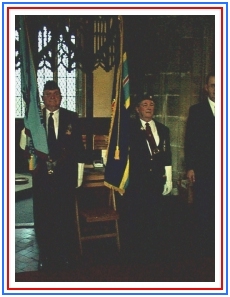
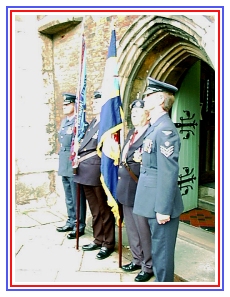
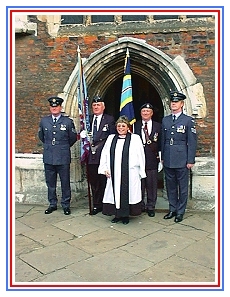
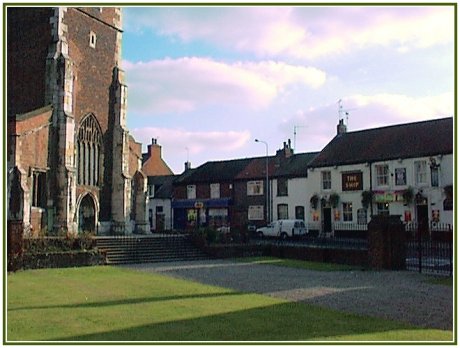
Sutton, St James', and The Ship Inn, home to the
memories of many an airman who trained here, and those
who manned and maintained the wartime balloon
defences.
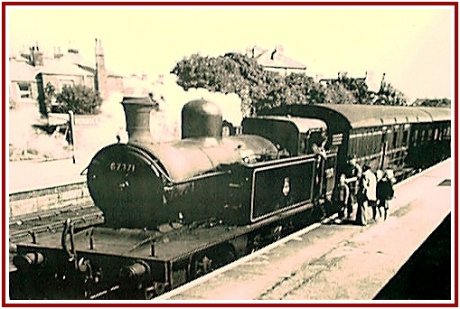
Sutton on Hull station ... a different station. This
is how many an airman arrived to take up his new
posting in this far-flung outpost of the British
Empire. If Hull was termed as being at the end of the
earth ... heaven only knows how all those men regarded
Sutton. I could just imagine them getting their
posting chit ... " Sutton ... Sutton on where ? Where
in heaven's name is that ?" And that's the polite
version ! But I've no doubt local Sutton folk made
them welcome ... 60 years later, some 200 wanted to
come back and remember their time here.

On
Wednesday, the 24th of September, 2003, Local
Historian Len Bacon presented this Hull City
Council plaque to Councillor Gemmell for display
on the wall of Bransholme Library. It commemorates
that in the area, there was in existence from 1939
to 1961, a Royal Air Force Station.
Originally designated as RAF 17 Balloon Centre, it was opened on Wednesday 28th June 1939, and from there during World War 2, the Balloon Barrage in the defence of Kingston upon Hull and the Humber Area was controlled and maintained. By September 1942, over 2,000 Royal Air Force and Women's Auxiliary Air Force personnel served at and from the Centre, which on the 15th October 1942 was renamed to become RAF Station Sutton-on-Hull. Also there was the home of the RAF School of Fire Fighting and Rescue from 1943 - 59.
The RAF Station was finally disposed of on Monday 14th August 1961. Covering 83 acres, the land was developed for the Bransholme (North Point) Shopping Centre, housing, and located centrally, the Bransholme Library which now displays this splendid commemoration.
The plaque has been sponsored from the proceeds of the sale of Len Bacon's book "Hull's Own Air Force Station", still available from Len at the Resource Centre in the Old School on Fridays, or the at Balloon Barrage Reunion Club, or of course, you can email Merrill or myself for further details. We'll be happy to help. We understand that there are not all that many copies left.
This
Hull City Council plaque is the first outside
the City Centre, the first marking of a World
War 2 defence installation, and definitely the
first on Bransholme Estate !
Go to a second page giving
MORE DETAILED INFORMATION
ABOUT
RAF SUTTON ON HULL
and the
HULL BALLOON BARRAGE
and
for details of a new video about
992 Squadron Balloon Barrage
at Queensferry in 1939.
War
Memorials & War Graves
and Civilian War Dead Index
There
are several Military Links,
to both the RAF and the other services,
on our Other Links
Page or click the button in the menu.
For another RAF link of interest to our area, there is a Battle of Britain pilot buried in Sutton churchyard. F/Lt Pat Hughes is credited with shooting down Luftwaffe ace, Franz von Werra, the famous German escapee who became renowned for his escaping prowess.
See more details
about Pat

Close
this page to
return to
Sutton & Wawne pages
or use this button if you have
already
closed your orignal page
and have locked yourself out.

A
link to something
a bit more modern
...
RAF
HOLMPTON
... was the
top-secret
underground Cold
War Bunker, built
in 1951-52 as part
of the UK's radar
defence shield.
It re-opens to the
public from 17 Feb
2007, with guided
tours.
| Below are a selection of photos, courtesy of Stephen Pascoe, who briefly lived in the married quarters when his grandfather, Alfred, was stationed here as Station Warrant Officer from around 1945, and up to the time when RAF Sutton was the premier fire-fighting training school for the RAF.. This first one is WO Pascoe being very businesslike at his neat desk around 1945, perhaps when he first came here. All work completed, and a very empty 'out' box. The high-tech comms system is worthy of note here.  WO Pascoe was officially credited as being heavily involved in the designing of early asbestos fire-fighting protection suits. He is seen here, around 1960, in this excellent photo riding the running board of one of the station fire trucks along with his training team. The other man perched precariously to his left is holding one of the newly designed suits.   ~ ~ ~ ~ ~ ~
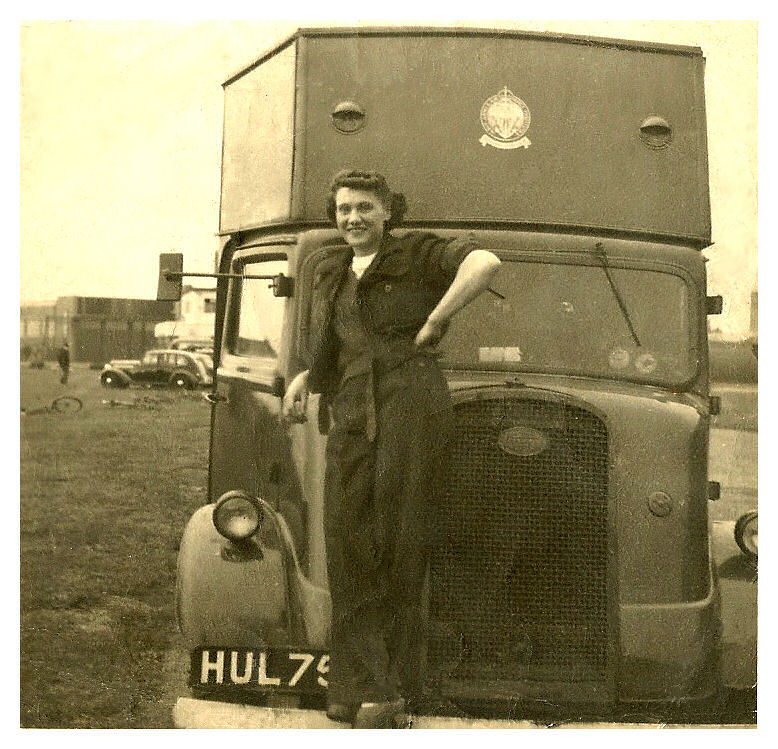 Amongst other
photos Stephen sent us were these of happy times.
Amongst other
photos Stephen sent us were these of happy times.Firstly, left, a camp sports day in 1956, with his mother, Lou, far left. And right, here earlier in the 50s with the NAAFI van she drove. Finally, we have a class photo of the early 60s, exact date unsure. Stephen attended St James', as did his brother Colin, before the family decamped to live in Cornwall, where Stephen lives now. I'm sure some of the other pupils here were also children of other RAF personnel at the camp, so from Sutton Gardens, those being the married quarters. Though Stephen lived with his family at 'Eastfield', a farmhouse just up Wawne Rd nearly opposite Lambwath Hall, and which adjoined the larger 'Westfield' and both premises backing onto the RAF camp itself.  Stephen also provided us with a bit
of history of the residents of Eastfield and other
locals he recalls.
"After retirement from the RAF, Grandfather Fred Pascoe lived there, with his wife May, youngest daughter Valerie (a pupil of Sutton School) and eldest son Arnold, who was the NAAFI Storeman on the camp after his war service in Europe with the 4th Dorsets. He ran the farm buildings and land of 1 acre as a smallholding, concentrating on poultry and pigs with a small market garden. Fred Pascoe moved to Cornwall in 1954 at which point his son, Arnold took over the smallholding. Arnold, newly married to Lou lived there, with in due course their sons Stephen and Colin, both in turn pupils of Sutton School, until they all moved to Cornwall in 1965. Not long afterwards I believe that the Bransholme development started. During the period in question the house next door, 'Westfield', was occupied by farm workers employed by Mr Stamford Smith; from memory they were in chronological order; Joe Speck, Mr Bayram and Mr Palmer. Note: spelling not guaranteed." All these photos are 'clickable' to enlarge, and are naturally 'copyright' to their owner, and appear here by kind permission of Stephen Pascoe. FLIGHT -Service Aviation was an amazing archive of most wartime issues of this magazine, issued to RAF and Fleet Air Arm personnel throughout the war. Apart from the general historical interest re aircraft, what is most useful to family historians is the huge amount of info and data given, each six months, on casualties, promotions, decorations and awards, as well as missing presumed killed, and notified prisoners of war. Yes, even down to Mentioned in Despatches, so notoriously hard to find. There were two issues a year, in January, and July, and they were huge files, and took some time to open in Adobe Acrobat. Unfortunately,
these are no longer 'easily' available
online, the site having ceased to
exist. But some of the issues, not all
sadly, have been preserved on "The Wayback
Machine", the tremendous internet archive
that trawls the web constantly and has so
far saved over 80 BILLION pages
worldwide. Seriously. It all
depends on how much you really want to see
these historic old RAF issues, just how much
'faff' you are willing to go to. If
none, leave now.
The trick is to click one of these files, load the blank page, but note and copy the address bar link gives you into the WBM. I've removed the issues no longer available, mosty second half of each year. Then go to the WBM, like for Len Bacon's RAF Sutton site detailed above, paste the full address into their search page, and these PDF files will download into your own machine. Honest. |
